 Enrique R. Lamadrid and Juan Estevan Arellano, illustrated by Amy Córdova,
Enrique R. Lamadrid and Juan Estevan Arellano, illustrated by Amy Córdova,
Juan the Bear and the Water of Life / La Acequia de Juan del Oso
University of New Mexico Press, 2008.
Ages: 7+
The 19th century waterways that irrigate the Upper Mora Valley in New Mexico’s Sangre de Cristo Mountains are a marvel of engineering to this day. In places, the water seems to defy gravity, and no one is quite sure how the people who built them—lacking tools as basic as a metal-bladed shovel—accomplished it. Though the history of their construction is lost, stories about the dedicated pioneers who built them have evolved, through oral tradition, into regional legends presented here in picture-book form.
La Acequia de Juan del Oso comes from the story of “The Three Juanes”: the remarkably strong Juan del Oso, son of a local woman and a bear; Juan Mudacerros, who moves mountains; and Juan Mudarríos, who can change the course of rivers. Folklorists Enrique R. Lamadrid and Juan Estevan Arellano recognize similar characters in Spanish tradition, from which the acequia technology of the American Southwest is also derived. The super-human young men, all of them exiled from their communities as a result of unintentionally misusing their special strengths and powers, work together as only they can to bring the water up and over the mountain. Amy Córdova’s rich and colorful illustrations bring the landscape and characters to life in this story that is not only about the reward of hard work but also the pain of exclusion and the value of community.
The authors skillfully incorporate what is known about the building of the canals (such as rudimentary tools, including a half-empty brandy bottle used as a level) with the legend of the boy whose mother married a bear but is forced to return home. When an innocent swipe seriously injures another child, the half-bear Juan flees to the woods where he finds his welcoming father and the other legendary Juanes. Together they accomplish the work that enables the expanding village population to inhabit a valley on the other side of the mountain. This book brings both the folktale and the limited known history of the acequia together in a way that celebrates not only the past and the legends but also the people who live in the Mora Valley today who continue to make a beautiful life in this stark, arid, and high-altitude environment.
Abigail Sawyer
May 2012
LOTUSLAND AT THE TATTERED COVER
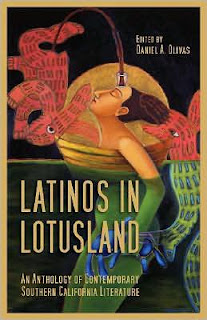
On May 21,
Rudy Ch. Garcia and I hosted a reading and signing event for
Latinos In Lotusland at the Colfax Avenue version of the
Tattered Cover Bookstore in Denver. The bookstore people, as always, were gracious and accommodating; the audience was attentive and eager to hear about this amazing collection of short stories that features more than thirty writers; and the night turned into one of those where everything fell into place and a great time was had by all. Camaraderie and affection filled the air as old friends greeted one another with enthusiastic hugs, while strangers shook hands and introduced themselves. Everyone was primed for a literary evening, and no one left disappointed.
A great crowd showed up for the event.
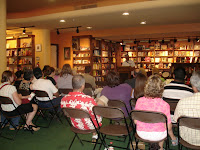
I opened the evening with some comments about
Daniel Olivas's original call for "provocative stories ... from social realism to
cuentos de fantasma and anything in between" as long as Los Angeles played an integral role. I pointed out that one of Daniel's goals was to bring together some of the "best contemporary Latino fiction" about Los Angeles. And then Rudy and I set out to demonstrate to the audience how well Daniel had succeeded in reaching his goal.
We had decided to give our audience as broad a taste as possible of the varied delicacies in the book by reading short samples from several of the stories. My selections focused on stories about writers, so I proceeded with the opening paragraphs from Luis J. Rodriguez's Miss East L.A., which made the audience laugh, even though there was a certain edge to the laughter. Then a few pithy paragraphs from Wayne Rapp's Just Seven Minutes that made the audience smile knowingly and laugh again; and finally a couple of paragraphs from my own The 405 Is Locked Down.
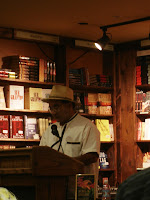
Rudy continued, in his inimitable style, with more short pieces. He opened with a page from
Luis Alberto Urrea's The White Girl, quickly moved to several paragraphs from
Frederick Luis Aldama (A Long Story Cut Short); came on strong with choice words from
Kathleen de Azevedo's The True Story; and finished with his own
LAX Confidential. We both wished we had more time to read more selections, but the ones we did manage to fit in were applauded enthusiastically by the audience. Later, several attendees told us that they appreciated the way we presented the stories, whetting their appetites, leaving them with the desire to hear more and, thus, to buy and read the book.
We answered questions: were there any pachuco stories in the collection (check out
Kid Zopilote by
Mario Suárez); why is profanity necessary in some stories and not in others (Rudy handled that); would we rather write short stories or novels (we like shorts, we like novels, we just want to write); is there a bias in the publishing world against writers from mid-America (h-m-m-m).
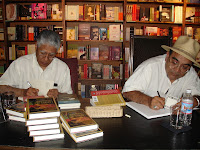
We finished by signing books for those who wanted autographs. We mingled a bit, took a few photos, then several of us ended up at the nearby
Neighborhood Flix Café bar, where old and sometimes class
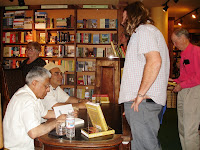
ic movies show continuously on the walls, and you can take your beverage of choice into the theater to watch movies like
The Favor, Anamorph and
21. We toasted the book, toasted one another, and speculated about another short story collection, maybe something like
Latinos in the Rocky Mountains. What a night.
 Rudy surrounded by his proud family at his first reading for a published story.NEW FROM NEW MEXICO PRESS
Rudy surrounded by his proud family at his first reading for a published story.NEW FROM NEW MEXICO PRESSThe following is from the
UNM Press Fall 2008 catalog:
 The Song of Jonah Gene Guerin
The Song of Jonah Gene GuerinIn this modern retelling of the Book of Jonah, Fr. Jon, like his biblical counterpart, rejects the call from God to his own “Nineveh.” In an ironic echoing of Jonah’s fate, the priest is swallowed up by a metaphorical whale and deposited on the very shores of the place he was determined to avoid. Nueve Niños, with its long-standing reputation for mistreating its pastors, is an alien world that will prove his ultimate testing ground. Through his slow, often reluctant immersion into the lives of the villagers, Fr. Jon eventually gains insight into himself and his ultimate calling.
Gene Guerin’s novel
Cottonwood Saints (UNM Press) won the
Mountains and Plains 2007 Regional Book Award for Adult Fiction and the
2006 Premio Aztlán for first-time Hispanic writers. Born and raised in New Mexico, he presently lives in Denver.
 ChupaCabra and the Roswell UFO
ChupaCabra and the Roswell UFO
Rudolfo Anaya
In this second ChupaCabra mystery, Professor Rosa Medina has just arrived in Santa Fe where she meets Nadine, a mysterious sixteen-year-old who insists that the two of them travel to Roswell, New Mexico. Nadine is convinced that C-Force, a secret government agency, has decoded the DNA of ChupaCabra and an extraterrestrial. If the two genomes are combined, a new and horrific life form will be created.
In this fast-paced mystery, Anaya expands the ChupaCabra folklore into a metaphor that deals with the new powers inherent in science. Is ChupaCabra a beast in Latino folktales, used to frighten children, or a lost species being manipulated by C-Force? Rosa’s life hangs in the balance as she and her young accomplice try to find a way to stop C-Force before its mad scientists create a monster.
Rudolfo Anaya has received numerous awards, including the
Premio Quinto Sol, the national Chicano literary award, the
National Medal of Arts for literature, the
PEN Center West Award for Fiction, the
American Book Award from The Before Columbus Foundation, the
Mexican Medal of Friendship from the Mexican Consulate, and the
Western Literature Association’s Distinguished Achievement Award.
 Juan the Bear and the Water of Life La Acequia de Juan del Oso
Juan the Bear and the Water of Life La Acequia de Juan del Oso
Retold and Translated by Enrique R. Lamadrid and Juan Estevan Arellano; Illustrated by Amy CórdovaLa Acequia del Rito y la Sierra in the Mora Valley is the highest and most famous traditional irrigation system in New Mexico. It carries water up and over a mountain ridge and across a sub-continental divide, from the tributaries of the Río Grande to the immense watershed of the Mora, Canadian, Arkansas, and Mississippi Rivers. The names and stories of those who created this acequia to sustain their communities have mostly been lost and replaced by myths and legends. Now, when children ask, some parents attribute the task of moving mountains and changing the course of rivers to Juan del Oso, the stouthearted man whose father was
a bear.
From the mountains of northern Spain to the Andes in South America, Spanish-speaking people have told ancient legends of Juan del Oso and his friends. In this children’s tale, agriculturalist Juan Estevan Arellano and folklorist Enrique Lamadrid share a unique version of a celebrated story that has been told in northern New Mexico for centuries.
Enrique R. Lamadrid, professor of Spanish folklore and literature at the University of New Mexico, was awarded the
Americo Paredes Prize in recognition of his work as a cultural activist. Juan Estevan Arellano, a native of Embudo, New Mexico, is a poet, artist, writer, and agronomist. He is an expert in traditional Spanish/Moorish agriculture and the sustaining of traditional crops originally brought to New Mexico from Europe and Central Mexico. Amy Córdova lives in Taos, New Mexico, where she is co-owner of
Enger-Córdova Fine Art. She is also an educator and has illustrated many children’s books.
Later.
 Enrique R. Lamadrid and Juan Estevan Arellano, illustrated by Amy Córdova,
Enrique R. Lamadrid and Juan Estevan Arellano, illustrated by Amy Córdova,












Addendum:
Tattered Cover rarely does readings for short story collections because turnout is usually low.
They informed us this event was the best turnout ever!
My advice for first-time authors doing a booksigning: come prepared with some inspirational messages because you will be asked to come up with something--on the spot!
RudyG
What a wonderful report and great photos of the book reading! I wish I could have been there but our son turned 18 that day and life in Lotusland has been busy of late. You vatos make me so proud and, yet again, you've confirmed the importance of this project. Please send my thank yous to the fine people at the Tattered Cover.